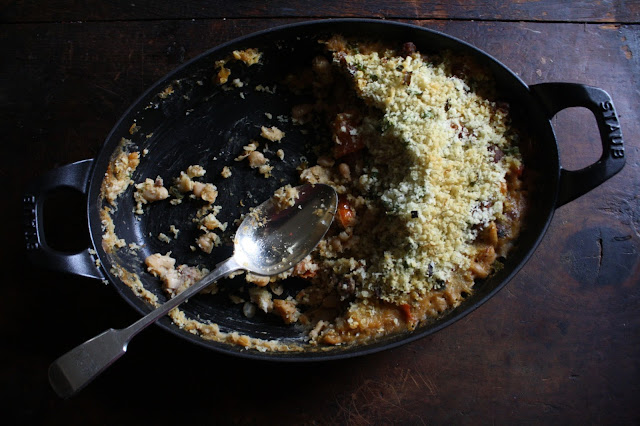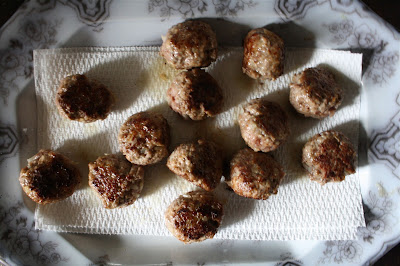My first thought upon seeing these almost too beautiful to eat Swedish Cinnamon and Cardamom Buns posted by a fellow foodblogger was 'I need to make them'. This was immediately followed by 'these look a little beyond my pastry and bread making skill set'. Being someone who is currently having significant difficulty wrapping my head around motor planning through a burpee, I wondered if making these buns would be another one of those challenges getting the best of me. Having my self-esteem take two hits in one week would border on a form of self-abuse I was pretty certain wasn't exactly in my best interest. If there was at least one consolation, it would be no one would be able to publicly see me struggling with one of them.
In spite of reading the recipe and pouring over
Johanna Kindvall's one-dimensional drawings on forming each of the individual Swedish Cinnamon and Cardamom Buns, I still couldn't wrap my head around how she got them to look so beautiful. Could a trip to bakeries in Sweden, a virtual trip via YouTube that is, take me from feeling clueless to being Swedish bun (
Kardemummabullar) I CAN do this confident? YES! Not only did I finally have that 'ah-ha' moment, I became so entrenched in watching Swedish videos I think I may have qualified for Swedish citizenship.
If I said these Swedish Cinnamon and Cardamom Buns were similar to Cinnamon Rolls I may inadvertently be misleading you or risk offending someone somewhere. And if I said they were much easier to make than Cinnamon Rolls, yet equally as delicious, I wonder if you will believe me considering all of my initial trepidations. I suppose you will just have to make them to decide for yourself. Or miss out knowing how OMG, melt in your mouth, delectable they are.
Here are some of the reasons why they are easier to make than traditional American cinnamon rolls: (1) you don't need a standing mixer with a dough hook, the dough simply comes together with your hands; (2) you don't need to feel like you are getting an arm workout kneading the dough, as in less than 5 minutes the dough becomes smooth and has the perfect elasticity; and (3), you don't need to wait hours for the first dough rise, it doubles in size in approximately an hour if placed in a warm, draft-free space.
If there was ever a dough to cure anyone suffering from dough-phobia, this would be it. I knew from the taste and texture of the dough alone that these Swedish Cinnamon and Cardamom Buns would be incredible.
After dividing the 'after the first rise' dough in half, it is rolled out into a 12"x18" rectangle. Half of the butter-cinnamon-cardamom mixture is spread evenly over the dough (all the way to the edges) before folding the dough in half. Now this is where I could tell you to cut the dough into approximately 1 1/4- 1 1/2 inch strips, then cut each strip in half (without cutting into the fold), first twisting each side of the strip then braiding both sides of the strip together, wrapping into a bun and placing on a parchment paper lined baking sheet. But if you too are more of a visual learner, here is a
link to one of the videos that made the bun formation process easy to understand (seen shortly after the video's 6 minute mark). One of the more
humorous videos watched demonstrated another way of forming these buns (about 2 minutes into the video). The point of sharing both of these two techniques with you (don't forget to look at Johanna's drawings) is that there is almost no way you can mess them up.
Once the dough is formed into these gorgeous buns, they are covered and allowed to rise for additional 45-60 minutes (or until puffy).
All of the 'second rising' buns are brushed with beaten egg and sprinkled with Swedish pearl sugar (my favorite is made my
Lars and can be found at some grocery store or speciality food stores as well as bought on
Amazon.)
Be generous with your sprinkling of the Swedish Pearl Sugar.
In a preheated 425 degree (F) oven, the Swedish Cinnamon and Cardamom Buns bake for approximately 8-10 minutes. Note: My baking time was between 9:30 and 10 minutes. I put one baking sheet into the oven at a time rather than risk having both pans of buns come out looking and baking differently.
Immediately remove the baked buns from the baking sheet and transfer to a cooling rack. Keeping the buns on the hot baking pan may cause them to continue baking, which will cause them to lose their moistness. Don't resist the temptation to eat them while they are still warm.
Cardamom is a spice with a strong, unique taste.
Serious Eats describes cardamom's difficult to describe complex flavor as 'part-nostril widening menthol, part dew-drenched flower, part-honeyed syrup'. If you are unfamiliar with its' taste, these buns would be a great place to first experience it, particularly due its' pairing with cinnamon. Yes it is on the expensive side. But spice stores and some grocery stores (like Whole Foods) allow to buy 'what you need' from their spice bins.
While they are equally delicious room temperature, I couldn't help but want to recreate the taste of warm baked dough. So I heated them up (on low power) in the microwave. They were perfect.
It just so happened that I made these Swedish Cinnamon and Cardamom Buns while the person who shall remain nameless was traveling for work. To add insult to injury I texted him a photo of these over the top deliciously beautiful buns as soon as they came out of the oven. It wasn't that I was being wicked, I just couldn't contain my enthusiasm for being able to make buns I thought were destined to send my self-confidence plummeting. Before you go and start thinking too ill of me, I froze half of them. So when he returns back home I will reheat them in the microwave and he can experience their hot out of the oven scrumptiousness. Having already reheated one of these frozen buns, I learned they freeze and reheat incredibly well.

If watching more than my fair share of videos on youtube gave me the confidence I needed to form these beautiful Swedish Cinnamon and Cardamom Buns, maybe I should consider watching some youtube how-to burpees videos. Especially if I want to stop looking and feeling so uncoordinated in public. Although watching extremely fit people do burpees effortlessly may do even more irreparable harm to my self-esteem. Think if I bring in a platter of these gorgeous eye-candy Swedish Cinnamon and Cardamom Buns to my next circuit training class no one will see (or remember) the ungraceful burpee attempts being made by this aging ex-cheerleader? Possibly.
Recipe
Swedish Cinnamon and Cardamom Buns (inspired by Johanna Kindvall's Kardemummabullar (Cardamom Buns) as shared on her blog Pantry Confidential)
Ingredients
Dough
7 Tablespoons (99 grams) unsalted butter
1 1/2 cups whole milk
2 teaspoons active dry yeast
4 1/2 cups (638 grams) all-purpose-flour
1/4 cup (50 grams) granulated sugar
1 1/2 teaspoons cinnamon
1/4 teaspoon kosher salt
Filling
7 Tablespoons (99 grams) unsalted butter, room temperature
1/2 cup (99 grams) granulated sugar
4 teaspoons ground cinnamon
2 teaspoons ground cardamom
Topping
1 large egg, beaten
Pearl sugar (recommend Lars Pearl Sugar)
Directions
1. Melt butter in a saucepan. Stir in milk, heating until warm to the touch (110 degrees F).
2. In a smal bowl, dissolve yeast in 2 to 3 Tablespoons of warm butter/milk mixture. Stir and let mixture sit until bubbles form on the top of the yeast. Note: Keep reserved milk/butter mixture.
3. In a large bowl, mix together the flour, sugar, cinnamon, and kosher salt. Add the yeast mixture along with remaining butter/milk mixture. Work together with your hands until you can form the dough into a ball.
4. Transfer the dough to a flat surface and knead until it is smooth and elastic (approximately 3-5 minutes). Notes: (1) The dough should feel moist, however, if it sticks to your fingers add a small amount of flour. (2) The dough is fully kneaded when you slice into with a sharp knife and see small air bubbles throughout.
5. Return the dough to the bowl, cover with a clean towel, and place in a warm, draft free place to rise until doubled in size (approximately 1 hour).
6. Before the dough has finished rising, make filling. Cream together the room temperature butter, sugar, and spices until the mixture is an evenly mixed and spreadable paste. Set aside.
7. After the dough has finished rising, cut the dough in half. Roll one half out on a flat, lightly floured surface into a 12 inch by 18 inch rectangle. Place the rectangle on the surface so that the long side is closest to you.
8. Carefully spread half of the filling on half of the dough, bringing the filling to edges of the dough. Fold the dough in half (should have a 6 inch by 18 inch rectangle). Slice into 12-14 equally sized pieces. Cut, twist, and shape into buns, placing them on a parchment paper lined baking sheet. Repeat with second half of the dough. Note: Either look at Johanna Kindvall's post or watch the youtube videos linked above.
9. Cover the buns with a clean flour sack or tea towel and let rise for 45-60 minutes, or until puffy.
10. Preheat oven to 425 degrees (F).
11. Brush the buns with an egg wash and sprinkle generously with pearl sugar. Bake for 8-10 minutes, rotating pans from front to back halfway through the baking.
12. Transfer baked buns to a cooling rack. Serve warm or cool completely. Buns can be stored in an airtight container in the freezer and reheated in the microwave.

















































